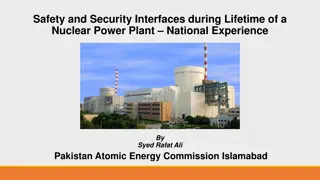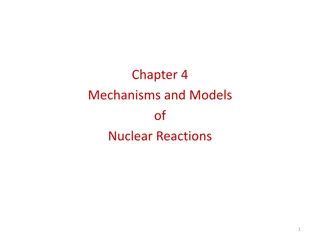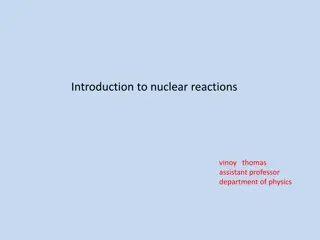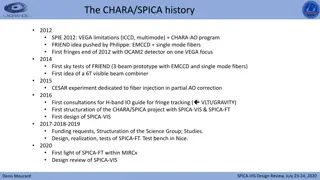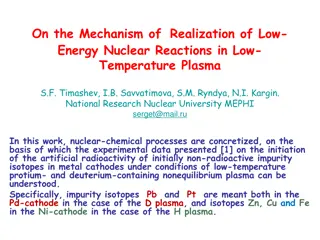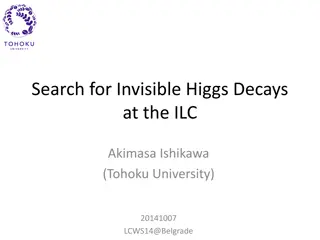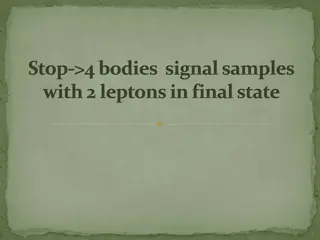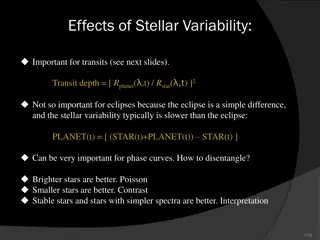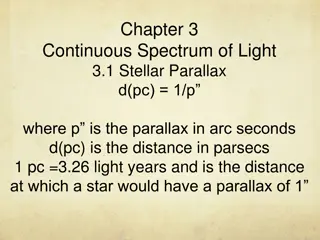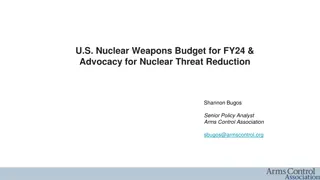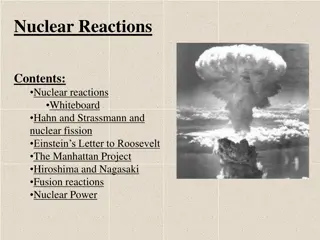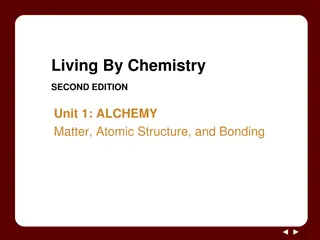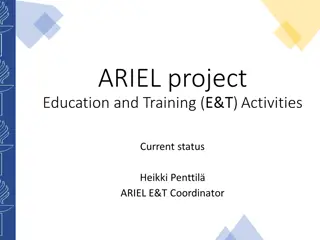Nuclear Decays and Reactions in Stellar Astrophysics
Nuclear decays and reactions, driven by weak interactions, are vital in stellar astrophysics. Various processes like bound-state beta-decay impact nucleosynthesis and cosmochronology. Specific processes in stars involve capture reactions, electron capture, and neutrino-nucleus interactions. Stellar plasma conditions influence decay processes significantly. Studies from 1983 to 2005 showcased the measurement and prediction accuracy in bound-state beta-decay. Understanding atomic vacancies and ionized states is crucial for explaining nuclear processes in stars.
Download Presentation

Please find below an Image/Link to download the presentation.
The content on the website is provided AS IS for your information and personal use only. It may not be sold, licensed, or shared on other websites without obtaining consent from the author.If you encounter any issues during the download, it is possible that the publisher has removed the file from their server.
You are allowed to download the files provided on this website for personal or commercial use, subject to the condition that they are used lawfully. All files are the property of their respective owners.
The content on the website is provided AS IS for your information and personal use only. It may not be sold, licensed, or shared on other websites without obtaining consent from the author.
E N D
Presentation Transcript
When Michels favorite tiny electrons fool the big atomic nuclei in the skies Marcel ARNOULD Institut d Astronomie et d Astrophysique, ULB By way of an illustration : the phenomenon of Bound-State Beta-Decay and its implication on Stellar Nucleosynthesis and Cosmochronology
A brief introduction Nuclear decays and reactions via weak interaction play a key role in many fields of stellar astrophysics A larger variety of such processes can develop in stars than in the laboratory Common processes in normal lab conditions ???? : (Z,N) --> (Z+1, N 1) + ? + n? ????+: (Z,N) --> (Z-1, N+1) + ?+ + n? _ --> (Z-1, N+1) + n? Bound Electron Capture : (Z,N)+ eb
Specific Processes in Stars _ --> (Z-1, N+1) + n? ????????? ? capture : (Z,N) + ec Positron Capture : (Z,N) + e+ --> (Z+1, N-1) + n? Bound-State -Decay : (Z,N) --> (Z+1, N-1) + n? In addition A large variety of Neutrino-Nucleus Interaction processes including Neutral-Current processes
Stellar plasma conditions affect -decay processes in many ways Temperature effects: Decay of thermally populated nuclear excited states Temperature + density effects: Reduction of emitted lepton phase space (Pauli principle) at high density + low temp. (Fermi-Dirac statistics) Capture of e+ , free e- : Exo -, as well as endothermic transitions possible (Fermi energy) Ionization : Bound e- rate = f (stellar conditions) (e.g. 7Be) Bound state -decay STARS = WORLD OF VARIABLE DECAY CONSTANTS !
Back to Bound-State Beta-Decay 1983-1987 19921996 2005 1947 1961 Measurements Calculation probabilities Prediction Daudel et al. 205Tl Bound/continuum Oktsubo et al. 187Re Bosch et al. Takahashi and Yokoi Bahcall 163Dy Jung et al. ESR: Experimental Storage Ring GSI Darmstadt Remarkable Agreement !
An Obvious Pre-requisite : vacancies in atomic shells (esp. lowest energy ones) Population of ionized states in local thermodynamic equilibrium : Saha equation Population of given atomic state = f(T, , mass ions, ionization potentials, atomic partition function) Note complication: atomic states of ion perturbed by : Other bound electrons Surrounding free electrons/ions
Ionisation potentials in stars smaller than laboratory values ( Depression of continuum ) (Much work for atomic physicists !!) Another important requirement: The emitted electron must have a low enough energy to efficiently populate a vacant atomic state
Complications in the calculation of energetics of transition Qn = Neutral atom ground state mass difference has to be corrected - Differences between energies of initial and final atomic states involved and total binding energies of electron clouds in initial and final ions - Depression of continuum (see Takahashi and Yokoi, Nucl. Phys. A404, 578, 1983 for details)
Comparison between bound-state beta-decay and normal beta--decay Complete ionization Allowed transitions only
The Bound-State Beta-Decay and Nucleo-Cosmochronology Evaluation of the age of Solar System nuclides Tnuc (time between beginning of galactic nucleosynthesis in disc and present epoch age of Galaxy TG) Basis : use a suitable chronometric pair A (unstable) B (stable/unstable) Requirements for a good pair I. Decay half-life accurately known II. Half-life commensurable with galactic age III. Accurate abundance data in present Solar System (meteorites) A/B TG (obs) (age of solar system known ~ 4.6 Gyr) IV. Good model for evolution of the nuclidic content of galactic disc up to time of isolation of Solar System (a formidable problem !) A/B TG(th) A/B TG (obs) A/B TG (th) TG
Most famed chronometric pairs for evaluation of TG Most famed chronometric pairs for evaluation of TG 232Th (1.4 1010 y)/238U (4.5 109y) 235U (7 108 y)/238U (4.5 109y) Poor predictive power ! (Yokoi et al., Astron. Astrophys. 117 (1983) 65) 187Re (4.4 1010 y)/187Os (stable) (Reasonable) Hope !
The 187 Re-187Os Pair ADVANTAGES Apart from radiogenic (187Os)RAD contribution from 187Re decay, 187Os made in s-process (187Os)RAD = (187Os) - (187Os)s Some problems, but INCONVENIENTS 187Re clock runs differently in different stellar zones, interstellar medium !Bound state Beta decay! 187Os (EC) 187Re in certain stellar zones Difficulties in predicting yields from individual stars Difficulties in predicting galactic 187Re content at given time 0< t TG
Beta-Decays in stellar plasmas and ionization The case of 187Re 3/2- 134 keV 9.75 keV 5/2+ 187Re75+ 5/2+ ~5X1010 yr Q=63.22keV - 3/2 1/2 2.66 keV - 9.75 keV 187Re 75 187Os 76 187Os75+(K shell) t1/2[y] Number of electrons bound to 187Re
And now, the ultimate step ! Put all the necessary ingredients [geochemical data, astronomical observations, astrophysical modellings, nuclear, atomic experiments and theory] into the grand galactic blender What comes out from the Re-Os recipe : 13 < TG < 18 Gyr ~ ~ (Latest news from Takahashi, Nucl. Phys. A718 (2003) 325c) Not incompatible with other chronometric predictions Clearly still a long way to go to improve predictions
Michel .. !!! Your help would be greatly appreciated !!! You will have plenty of free time soon to become an astrophysicist at last
Illustration impact of bound-state beta-decay on nucleosynthesis : the case of the production of 164Er Production of the nuclides heavier than iron : the s-, r- and p- processes 164Er (Z=68, N=96) : An s- or/and p- process origin ? All p-process models largely underproduce 164Er s-process models cannot produce 164Er, except if bound- state -decay is invoked !
CONC. 2 Details of the s-process path 164Er 98 96 94 e- + Er 68 162 164 166 (n, ) - Ho 67 - Dy 66 164 160 162 St e- Normal s-Process path s- process path with 163Dy Bound-State Beta-Decay
CONC. 3 The Bound State Beta-Decay of 163Dy 9/2- 167.34 9/2- 100.0 7/2- 73.44 7/2- 4750y 2.6 keV 5/2- 163Dy 163 Ho Bound-State Beta-Decay from excited states With Bound-State Beta- Decay, the s-process could account for the solar 164Er content Takahashi and Yokoi Continuum electron captures from excited states (1983)
CONC. 4 S-Process production of 186Os, 187Os Z 186Os 187Os - 76 (n, ) 185Re 186Re 187Re 75 e-c 184W 185W 186W 187W 74 N 110 111 112 113 Ground-state (n, ) cross sections known experimentally but complication due to contribution to (n, ) rates of populated nuclear excited states (esp. 9.75 keV first excited state of 187Os) (some recent experimental and theoretical results, but some uncertainties remain)
CONC. 5 The galactic blender


![[PDF⚡READ❤ONLINE] Cosmology and Particle Astrophysics (Wiley-Praxis Series in As](/thumb/21627/pdf-read-online-cosmology-and-particle-astrophysics-wiley-praxis-series-in-as.jpg)


